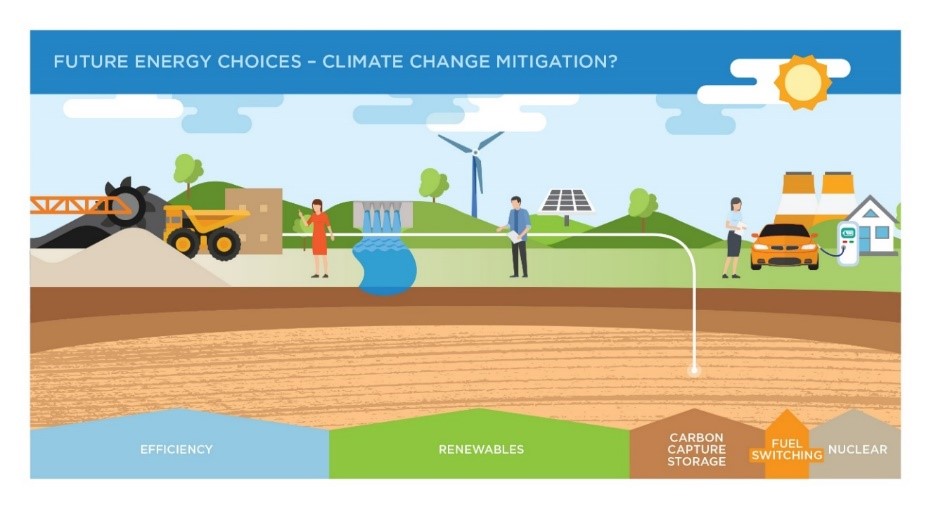About carbon capture & storage
What are our future energy choices?
In transitioning to a low carbon energy future, could carbon capture and storage (CCS) be a real and material option for Queensland?
As a university, UQ has a responsibility to undertake scientific research which informs choices for more sustainable energy futures. As such, UQ has been undertaking research on CCS for several years, in addition to many other technologies.
The world is facing an increasing climate change impact as we continue to emit more greenhouses gases such as carbon dioxide. Excess CO2 traps more heat in the atmosphere and it becomes warmer.
Burning fossil fuels like coal and gas from power plants, running large industrial plants producing cement, paper and steel and agriculture are some of the main sources of greenhouse gas emissions, as indeed are virtually all of our transport activities. However, in the immediate to medium term, a rapidly growing, global population with a growing per capita energy demand, relies on all of these things to progress living standards and maintain stable economies.
To address climate change, 196 countries participated in the United Nations’ Climate Change Conference in Paris in 2015 to negotiate a global agreement to reduce greenhouse gas emissions – known as the Paris Agreement. When signing the agreement, participating countries agreed to take measures to reduce their carbon output to try and limit global temperature rise to “well below” two degrees Celsius.
According to the International Energy Agency (IEA) and others, carbon capture and storage, also called geosequestration, is one of the key ways of reducing gas emissions by storing carbon dioxide deep underground in suitable geological formations. In some cases, it is the only way to materially reduce emissions from some locked-in, stationary sources. While it is not a universal panacea, it could achieve significant abatement and buy us significant time (decades) to develop, licence and deploy alternative energy technologies.
This study centres on CCS potential in Queensland. We have a number of coal and gas fired power stations generating the majority of electricity for the state (90%). The cumulative emissions from this power generation are of the order of 29 million tonnes CO2 per year. Several of these plants are relatively new with projected life time of over 30 years; in particular, southern Queensland has three of the most modern, efficient, supercritical coal fired plants on the National Electricity Market (NEM).

-
What is Carbon Capture and Storage (CCS)?
Carbon Capture and Storage, or geosequestration, is a process used to capture carbon dioxide gas which is emitted while producing power (via coal or gas), steel, paper, cement etc. To keep excess CO2 from the atmosphere, it is captured at the power plant or factory, transported (by pipeline for instance) and safely stored permanently deep underground. CCS is one of the options for tackling climate change to reduce global CO2 emissions. The International Energy Agency suggest that no one option will be enough to meet global reduction targets.
-
What is carbon dioxide (CO2)?
Carbon dioxide is one of several so-called “greenhouse” gases. It is a colourless, odourless and non-combustible gas in the earth’s atmosphere, also formed during respiration. Natural sources include volcanoes and hot springs, and carbon dioxide is freed from carbonate rocks when dissolved in water and acids. It is produced by combustion of wood and other organic materials, as well as from fossil fuels such as coal, oil and natural gas. It is also one of the essential ingredients for carbonated water.
-
How does Carbon Capture and Storage work?
The technology is designed to abate (or reduce) carbon dioxide emissions from large, industrial, stationary sources such as cement, steel or power plants i.e. to prevent them from entering the atmosphere to mitigate climate change. It is done by either stripping the CO2 from the flue gases from industrial processes or by burning the fuel in special ways to produce emissions of pure CO2. The carbon dioxide can then be dried and compressed, transported safely, and stored deep under the ground.
-
Do we need Carbon Capture and Storage?
Many global energy analysts, including the UQ Project Director, think so.
In 2018, the Intergovernmental Panel on Climate Change (IPCC 2018) wrote a special report on “ … the impacts of global warming of 1.5°C above pre-industrial levels and related global greenhouse gas emission pathways”. That report concluded, “Different mitigation strategies can achieve the net emissions reductions that would be required to follow a pathway that limits global warming to 1.5°C with no or limited overshoot. All pathways use Carbon Dioxide Removal…”.
Similarly, in the International Energy Agency’s, World Energy Outlook 2018, Sustainable Development Scenario, Carbon Capture Utilisation and Storage (CCUS) “… accounts for 7% of the cumulative emissions reductions needed globally to 2040”.
Reducing the amount of CO2 produced by human beings is important if the world is going to stop significant increases in global temperatures leading to climate change. According to the International Energy Agency, the production of electricity and heat are the largest contributors to global CO2 emissions, with industrial processes also being significant. These are generally characterised by large stationary sources. On top of this, the demand for heat and electricity is set to dramatically increase worldwide over the coming years, and CCS is one energy technology that can reduce excess carbon dioxide entering the atmosphere in a material way (millions of tonnes reduced per installation).
Given delays in progress on emissions reductions, some important contributors believe that CCS may also be needed to assist with “negative” emissions i.e. carbon captured from combustion of bio-fuels and subsequently sequestered safely, deep underground (e.g. IPCC 2018). More recently (IEA 2019), with respect to the role of CCS, it has been noted that “… limiting CO2 storage availability … over the scenario period … [would require] … additional measures and technologies … in the power, industrial, transport and buildings sectors in order to achieve the same emissions reductions”; and would also, “… increase the cost of the energy transition.”
Click here to read about the CCS scoping project led by The University of Queensland.
 “The task ahead is fundamentally an ‘AND’ challenge. Reducing carbon intensity and carbon emissions across the globe requires renewables AND efficiency improvements AND carbon capture AND storage and hydrogen AND solar and nuclear AND…”
“The task ahead is fundamentally an ‘AND’ challenge. Reducing carbon intensity and carbon emissions across the globe requires renewables AND efficiency improvements AND carbon capture AND storage and hydrogen AND solar and nuclear AND…”
- Professor Andrew Garnett
Director of the UQ CCS project and Director of the Centre for Natural Gas
